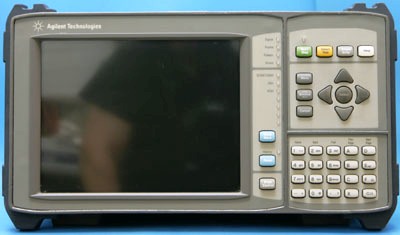
|
|
The Agilent J2127A Transmission Test Set provides a comprehensive range of tests and measurements for optical and electrical interfaces. Optical wavelengths, for line rates <= 2.5 Gb/s and 10 Gb/s can be either 1310 or 1550 nm, or can be interchangeable between both, depending on instrument option. All optical interfaces use the NRZ line code. For signal rates of <= 2.5 Gb/s, the wavelength range is 1260 to 1360 nm from the 1310 nm source, and 1500 to 1580 nm from the 1550 nm source. For signal rates of 10 Gb/s, the wavelength range from the 1310 nm source is 1290 to 1330 nm, and 1530 to 1565 nm from the 1550 nm source. The power range for signal rates <= 2.5 Gb/s is -5 to +0 dBm and -2 to +3 dBm at the 1310 and 1550 nm sources respectively. For 10 Gb/s rates, power ranges from -6 to -1 dBm at 1310 nm, -1 to +1 dBm at 1550 nm (HS), and -5 to -1 dBm at 1550 nm (SR). The output spectral width is <1.0 nm at both the 1310 and 1550 nm sources. The output extinction ratio is over 8.2 dB (option 111 & 121) or over 6 dB (option 120). Input wavelengths can range from 1200 to 1600 nm (standard) or 1280 to 1580 nm (option 120/121). The minimum sensitivity (< -33 dBm) occurs at rates of 52/155 Mb/s. The maximum input power is -8 dBm, with a maximum input damage power of > +3 dBm.The J2127A electrical interface line rates include STS-1/3 (STM-0/1e); DS1/3; 2/8/34/140 Mb/s, using CMI, B3ZS, B8ZS, AMI, and HDB3 line codes. The internal clock reference is accurate to +/- 4.5 ppm (including setting accuracy and stability due to aging and temperature change). External clcok inputs include a 1.5 Mb/s BITS, and a 2 MHz and 2 Mb/s MTS interface. Transmitted signals can be offset by +/- 100 ppm in 0.1 ppm steps. Also supported are the drop and insert of the section/regenerator section DCC channel (D1-D3) or the line /multiplexer section (D4-D12), using a unipolar signal with the most significant bit transmitted first. Payload signal structure analysis is also provided, with bulk STS-1 and STS-Nc, VT mappings and DSn/En service mappings supplied as standard (SONET). Provided SDH mappings include C-3, C-4 and C-4-Nc, TU mappings and DSn/En service mappings. Also supported are generation and analysis of framed, channel-structured (mux/demux) and unframed test signals for DSn/PDH formats and channel structures. Error measurements can be made manualy, one at a time (single) or from a timed start. Basic calculations include error count and error ratio, provided for the total measurement period and last measurement second. For SONET signals, alarms occur for LOF, OOF, AIS-L, RDI-L and K1/K2 change. SONET alarm signal payloads include pattern loss, clock loss, and power loss. For SDH signals, alarms occur for LOF, OOF, MS-AIS, MS-RDI, and K1/K2 change. The SDH alarm signal payloads include pattern loss, clock loss, and power loss. For DS1 signals, alrms occur for LOS, OOF, AIS, RAI, excess zeros and pattern loss. For DS3 signals, alarms occur for LOS, OOF, LOMF, AIS, RAI, idle, framing mismatch, DS2 LOF, excess zeros, and pattern loss. For 2 Mb/s PDH signals, alarms occur for LOS, LOF, LOMF, AIS, RDI, RDI (MF), minor alarm, and pattern loss. For PDH signals with rates of 8/34/140 Mb/s, alarms include LOS, LOF, AIS, RDI, minor alarm, and pattern loss. For SONET/SDH overhead testing, all path overhead bytes are user-programmable in hexadecimal. All overhead bytes are displayed by the overhead monitor, and text-based setup and monitoring of all trace messages, synchronization status messages, and payload signal labels are provided. The Agilent J2127A also provides SONET/SDH pointer adjustment control for STS-Nc/AU-4-Nc, STS/AU payload pointers and VT/TU pointers. The creation of a pointer transmits a new pointer adress with or without a new delta flag, supporting the setting of any valid point value. A single burst of adjustments are transmitted in a selected pointer. Adjustment polarity can be incrementing, decrementing, or alternating.
|